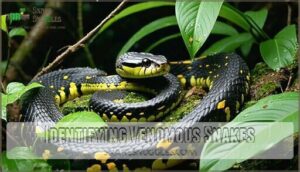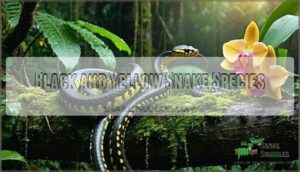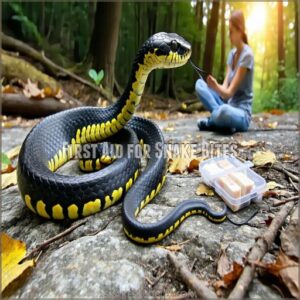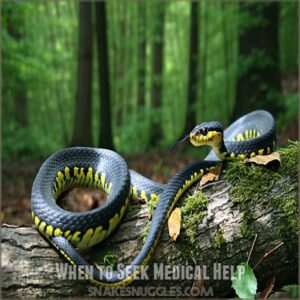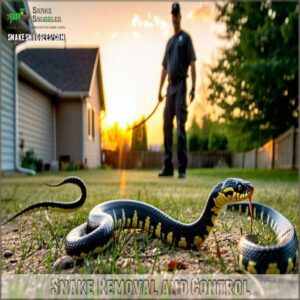This site is supported by our readers. We may earn a commission, at no cost to you, if you purchase through links.
1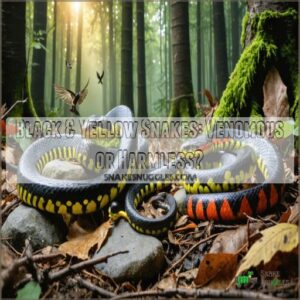
In North America, species like garter snakes and kingsnakes are harmless, showing off bold stripes or bands.
But watch out for the coral snake—its red, black, and yellow pattern is a clear warning sign of its potent neurotoxic venom.
Remember this rhyme: “Red touches yellow, kills a fellow.”
These snakes call forests, wetlands, and even backyards home.
Always stay cautious, avoid handling snakes, and if you’re unsure, admire them from a safe distance.
Recognizing patterns helps you stay safe and snake-savvy.
Table Of Contents
- Key Takeaways
- Identifying Venomous Snakes
- Black and Yellow Snake Species
- Snake Habitats and Behaviors
- Snake Safety and Precautions
- Snake Removal and Control
- Frequently Asked Questions (FAQs)
- What snakes are black and yellow in color?
- Are black and yellow snakes venomous?
- Do snakes have a yellow underbelly?
- What is an example of a black and yellow snake?
- Are bullsnakes black and yellow?
- What does a black snake with yellow stripes mean?
- Is a black and yellow snake venomous?
- What is the black and yellow snake in my yard?
- Is a black snake with a yellow belly poisonous?
- Are black and yellow garter snakes poisonous?
- Conclusion
Key Takeaways
- Learn to identify black and yellow snakes safely by recognizing patterns like coral snakes’ red-yellow-black bands and using rhymes like "Red touches yellow, kills a fellow."
- Always maintain a safe distance from snakes, avoid handling them, and never disturb their habitat, especially if you’re unsure about their venomous status.
- Non-venomous black and yellow snakes like garter snakes and kingsnakes play vital roles in pest control while coral snakes and kraits require caution due to their potent venom.
- Snake-proof your property by sealing entry points, trimming vegetation, and removing debris to reduce encounters with both venomous and harmless snakes.
Identifying Venomous Snakes
Spotting venomous snakes, especially black and yellow ones, can save your life.
Look for common venomous traits like fangs, elliptical pupils, or bold coloration warning signs.
Coral snakes, known for their red, black, and yellow bands, deliver potent snake venom types.
Remember the rhyme: “Red touches yellow, kills a fellow.”
For snake identification, note the bite marks—venomous snakes leave two punctures, unlike non-fanged species.
Understanding black and yellow snakes identification helps you confidently navigate their habitats safely.
Black and Yellow Snake Species
You’ll find a fascinating range of black and yellow snakes, from harmless kingsnakes to highly venomous coral snakes.
Recognizing these species helps you appreciate their unique patterns and better understand which ones to avoid, especially the coral snakes.
Coral Snakes
Coral snakes stand out among black and yellow snakes with their bold, tri-color bands.
Their neurotoxic venom makes them one of North America’s most venomous snakes, yet they prefer avoiding conflict.
Found in loose soil or leaf litter across forests and suburban areas in the southeastern U.S., they prey on lizards, frogs, and smaller snakes while avoiding predators through mimicry.
New World coral snakes, which include 83 recognized species, are primarily found across the Americas and are known for their vibrant warning colors.
- Habitat: Forests, sandy soil, and under leaves
- Venom: Potent neurotoxin affects the nervous system
- Behavior: Non-aggressive unless threatened
- Prey: Small reptiles and amphibians
- Mimics: Harmless snakes copy their warning colors
King Snakes
Unlike coral snakes’ deadly bites, you’ll find king snakes quite harmless.
These black and yellow snakes feature stunning patterns, from the California kingsnake’s bold stripes to the scarlet kingsnake’s vibrant bands.
You’ll spot them across North America, using their non-venomous traits to hunt other snakes.
Their defensive behaviors might look scary, but they’re excellent at controlling pest populations in your area.
To promote their well-being, it’s important to familiarize yourself with proper king snake care.
Garter Snakes
You’ll often spot garter snakes in your backyard, recognizable by their distinctive black and yellow stripes running down their backs.
These common garter species are nature’s pest control experts, feeding on insects, worms, and small amphibians.
While they might release a musky odor when startled, these non-venomous snakes are completely harmless.
Some individuals, such as melanistic garter snakes, feature black coloration that aids in thermoregulation and camouflage.
Just give them space, and they’ll peacefully go about their business.
Snake Habitats and Behaviors
You’ll find black and yellow snakes making their homes in diverse places, from your backyard garden to dense rainforests and coastal mangroves.
Whether they’re climbing trees to catch birds or slithering through grass hunting mice, these snakes adapt their hunting patterns to match their specific environments.
Where They Live
Now that we’re aware who’s who, let’s explore their addresses.
Black and yellow snakes show off cool Geographic Adaptation Patterns.
- Kingsnakes love backyards.
- Garter snakes enjoy water.
- Coral snakes prefer cover.
Regional Habitat Variations across North America influence their hangouts.
What They Eat
Black and yellow snakes use fascinating dietary adaptations to hunt based on their habitats.
Their prey selection includes:
- Small mammals like mice and voles, often found in their preferred habitats for prey.
- Birds, including eggs and nestlings taken opportunistically.
- Amphibians such as frogs and salamanders, especially in wet areas.
- Reptiles, including snakes, showcasing remarkable feeding mechanisms.
These snakes benefit from seasonal dietary adjustments to cope with changes in prey availability throughout the year.
Seasonal diet variations depend on prey availability.
Reproduction
Regarding snake reproduction, black and yellow snakes showcase fascinating variety.
Some are live-bearing snakes, giving birth to 15-40 young, while others are egg-laying species, nesting in hidden, warm spots.
Their mating behaviors often align with seasonal rhythms.
Many travel to shared dens for winter, a cozy gathering that’s more about survival than socializing—amazing examples of snake ecology at work!
Snake Safety and Precautions
When you encounter a black and yellow snake, staying calm and keeping your distance is key to staying safe.
Knowing how to avoid bites and what to do in case of one can make all the difference in preventing serious harm.
Avoiding Snake Bites
To avoid snake bites, wear proper footwear outdoors and steer clear of tall grass, rocks, or logs where snakes might hide.
Stay calm near snakes—don’t harass or handle them. At night, watch for movement and be cautious during nocturnal sightings.
Remember that understanding snake behavior can help you identify signs of stress or aggression, further reducing risks.
Recognizing snake threats and staying observant can help with snake bite prevention, keeping you safe from venomous snakes and accidents.
First Aid for Snake Bites
Panicking after a snake bite won’t help.
Instead, quickly clean the wound with soap and water to prevent infection.
Avoid ice, cutting, or suction – they’re bite myths.
Immobilize the area, keeping it below your heart.
For additional preparedness, consider carrying snake bite first aid supplies during outdoor activities in snake-prone areas.
Sketch or describe the dangerous snake (black and yellow?) if possible to aid doctors.
Always seek immediate medical help for proper wound care and possible antivenom.
When to Seek Medical Help
If a snake bite causes venom symptoms escalation like intense pain, rapid swelling, difficulty breathing, or neurotoxic bite signs such as dizziness or numbness, head to the hospital immediately.
Watch for severe allergic reactions like hives or throat swelling.
Medical centers offer antivenom availability for treating bites from venomous snakes, including black and yellow snakes, to counter dangerous snake venom effects effectively.
You can also learn more about antivenom for snakebites to better understand treatment options. Don’t hesitate!
Snake Removal and Control
When a black and yellow snake shows up in your yard, knowing how to remove it safely is important for both you and the snake.
Whether you call a professional or try a DIY approach, keeping your property snake-proof can help you prevent future visits.
Professional Snake Removal Services
Dealing with a black and yellow snake? Professional snake removal services help you handle venomous species and harmless ones alike.
Here’s what they offer:
- 24/7 Availability – Immediate response for any snake emergency.
- Snake Safety – Experts guarantee safe handling and relocation.
- Snake Identification Guide – Accurate identification to differentiate venomous snakes.
Affordable removal costs bring peace of mind fast!
DIY Snake Trapping Methods
Got black and yellow snakes wandering too close? DIY snake trapping can work wonders with simple tools and patience.
Create a basic snake funnel trap using a trash can and some plywood. Bait it with live mice or insect pheromones.
Always wear thick gloves while handling homemade catchers and avoid direct contact. Understanding snake handling safety is essential to prevent accidents when dealing with trapped snakes.
Before releasing trapped snakes safely away, remember to check your local rules—especially for venomous snakes!
Snake-Proofing Your Property
If venomous snakes and black and yellow snakes make you uneasy, snake-proofing is your best ally.
Start with a thorough property inspection to identify potential entry points.
Seal entry points like gaps in fences, foundations, or walls to shut snakes out. For snake control, try yard cleanup by trimming overgrown vegetation and handling debris removal—no snake wants a tidy yard!
Fence installation works wonders, especially if you bury the base 6–12 inches underground, which is an effective method of snake-proofing.
Enhance your snake-proofing with repellents like sulfur granules or ultrasonic devices.
With these tips, you’ll lower the chances of unwanted scaly visitors around your home.
Frequently Asked Questions (FAQs)
What snakes are black and yellow in color?
Think of a living warning sign – that’s the beauty of many black and yellow snakes.
Species like garter snakes, kingsnakes, and coral snakes showcase these striking colors, whether harmless or dangerously venomous.
Are black and yellow snakes venomous?
Not all black and yellow snakes are venomous.
Some, like garter and kingsnakes, are harmless, while others, like coral or banded kraits, pack serious venom.
Always stay cautious, and don’t handle snakes you can’t identify.
Do snakes have a yellow underbelly?
Yes, some snakes have a yellow underbelly.
For example, the plain-bellied watersnake and common watersnake often sport yellow bellies, helping them blend into their surroundings while moving between land and water.
What is an example of a black and yellow snake?
Imagine this scenario: you’re wandering through a sunny garden and spot an eastern garter snake, its dark body elegantly striped in yellow.
Harmless and non-venomous, this black-and-yellow beauty thrives in backyards, woods, and along streams.
Are bullsnakes black and yellow?
Bullsnakes often have a striking yellowish background with black or dark brown patterns, creating a bold contrast.
While not true black-and-yellow, their coloration can appear similar, especially on their mottled scales and stripes.
What does a black snake with yellow stripes mean?
A black snake with yellow stripes often signals harmless species like garter snakes, known for pest control.
Some, like the banded krait, are venomous.
Always observe from a distance and avoid handling unknown snakes.
Is a black and yellow snake venomous?
A black and yellow snake can be venomous or harmless, depending on the species.
Some, like the banded krait, are highly venomous, while others, like the common garter snake, are non-venomous and safe to observe.
What is the black and yellow snake in my yard?
The black and yellow snake in your yard could be a harmless garter snake or kingsnake, but it’s wise to keep your distance.
Observe patterns carefully since venomous species like coral snakes share similar colors.
Is a black snake with a yellow belly poisonous?
A black snake with a yellow belly likely isn’t venomous, but it’s tricky to say without proper identification.
Common suspects, like garter snakes or watersnakes, are harmless.
Still, it’s smart to admire from a safe distance!
Are black and yellow garter snakes poisonous?
Black and yellow garter snakes aren’t poisonous to humans, though they’re mildly venomous to their small prey.
Their venom is so weak it doesn’t pose a threat, making them harmless backyard visitors and excellent pest controllers.
Conclusion
Astonishingly, over 8,000 people are bitten by venomous snakes in the US each year.
Learning to identify black and yellow snakes, whether venomous or harmless, is essential for your safety.
Remember the key differences between coral snakes and their non-venomous look-alikes.
Respect their space, admire them from afar, and prioritize safety when encountering these fascinating reptiles.
By understanding their habits and habitats, you can coexist peacefully and appreciate the pivotal role they play in our ecosystem.
- https://www.britannica.com/animal/black-and-yellow-mangrove-snake
- https://nationalzoo.si.edu/animals/mangrove-snake
- https://thailandsnakes.com/yellow-black-snake-possible-identity/
- https://en.wikipedia.org/wiki/Yellow_anaconda
- https://www.smithsonianmag.com/science-nature/how-to-snake-proof-your-backyard-180964308/

